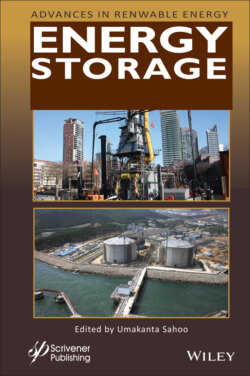Читать книгу Energy Storage - Группа авторов - Страница 21
1.3 Thermal Energy Storage in CSP
ОглавлениеThe intermittent and uncertain nature of solar energy are critical issues which cause a mismatch between source availability and energy demand. As a consequent, this results in ripples in the deployment and market penetrability of CSP technologies. Use of a backup system that uses nonrenewable energy is one of the solutions of such problems. In addition, another cleaner solution to this problem is use of a Thermal Energy Storage (TES) system. The TES system can store energy when solar radiation is abundant. The stored energy can be released during periods without the solar radiation. This results in uninterrupted electricity generation during nighttime or on a cloudy day. Since the last few years, TES has been an explicit and significant component of CSP plant with the ability to drive the turbine almost continuously. Thus, electricity can be generated continuously at night and during cloudy hours when sunlight is not available. In addition, CSP with TES provides utility-scale and dispatchable electricity to the power grid. Also, TES allows CSP plants to generate electricity during evening hours when electricity is highly valued, offering better cost effectiveness. The integrated TES system can also result in shorter start-up time of the absorber systems. The TES system can be installed after the receiver system as illustrated in the block diagrams of Figure 1.5.
Figure 1.5 Integration of thermal energy storage systems to a CSP plant.
The possibility of integrating the TES system is one of the most distinct advantages of the solar energy field with CSP over other renewable energy fields. There are many storage technologies being developed that can be integrated into CSP plants. To accelerate the development of solar energy power generation in terms of economy and operation, an efficient and cost-effective TES system is important. Many earlier research works have studied the importance of TES on CSP and this results in an energy-efficient power plant (Guo et al., 2018; John et al., 2013; Prasad and Muthukumar, 2013; Adinberg, 2011; Powell and Edgar, 2012; Tamme and Laing, 2004; Tian and Zhao, 2013).
Thermal energy storage concepts for CSP plants can be classified as active or passive systems. In an active TES system, the thermal energy storage material itself circulates through a heat exchanger. Active systems can be divided into direct or indirect TES systems. In the commercial CSP plants, only active TES systems are used. Commercial active direct thermal energy storage systems are molten salt systems and steam accumulators. A second medium is used for storing the thermal energy in an active indirect system. A heat exchanger is used to transfer thermal energy from HTF to the second medium.
Two different materials for heat storage and circulation are used for passive storage systems which are dual medium storage systems. The HTF passes through the thermal storage system only for charging and discharging a TES material. The TES material can store energy in terms of sensible or latent heat. Passive TES systems are still under major research and they have not yet reached the commercial CSP plant level. A brief discussion about different TES systems [Figure 1.6] as incorporated in commercial CSP follows below.
Figure 1.6 Reported integration of thermal energy storage systems in worldwide CSP plants.
